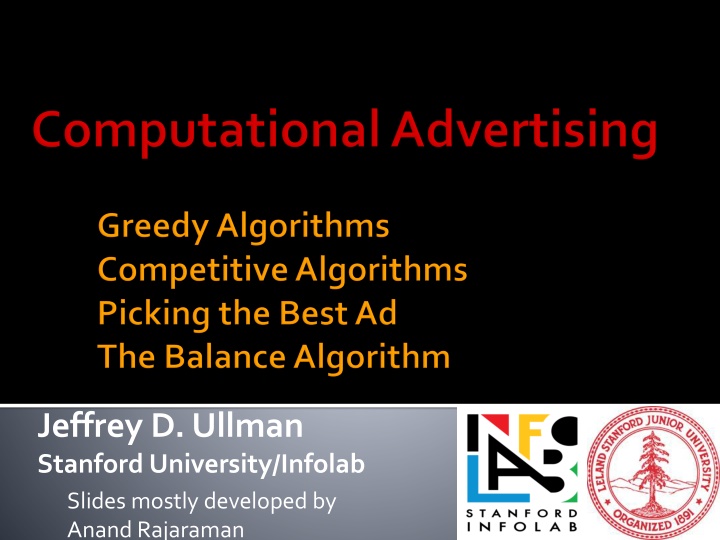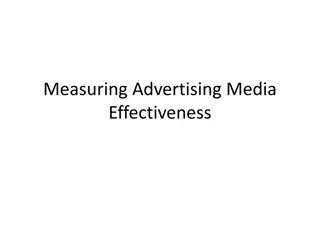
Optimal Matching Algorithms for Bipartite Graphs
Explore classic models of algorithms for bipartite graphs, focusing on the problem of finding maximum-cardinality matchings. Learn about offline and online algorithms, perfect matchings, and the competitive ratio of greedy algorithms compared to optimal solutions.
Download Presentation

Please find below an Image/Link to download the presentation.
The content on the website is provided AS IS for your information and personal use only. It may not be sold, licensed, or shared on other websites without obtaining consent from the author. If you encounter any issues during the download, it is possible that the publisher has removed the file from their server.
You are allowed to download the files provided on this website for personal or commercial use, subject to the condition that they are used lawfully. All files are the property of their respective owners.
The content on the website is provided AS IS for your information and personal use only. It may not be sold, licensed, or shared on other websites without obtaining consent from the author.
E N D
Presentation Transcript
Jeffrey D. Ullman Stanford University/Infolab Slides mostly developed by Anand Rajaraman
Classic model of (offline) algorithms: You get to see the entire input, then compute some function of it. Online algorithm: You get to see the input one piece at a time, and need to make irrevocable decisions along the way. Similar to data stream models. 2
a 1 2 b c 3 4 d Men Women Two sets of nodes. Some edges between them. Maximize the number of nodes paired 1-1 by edges. 3
a 1 2 b c 3 4 d Men Women M = {(1,a),(2,b),(3,d)} is a matching of cardinality |M| = 3. 4
a 1 2 b c 3 4 d Men Women M = {(1,c),(2,b),(3,d),(4,a)} is a perfect matching (all nodes matched). 5
Problem: Find a maximum-cardinality matching for a given bipartite graph. A perfect one if it exists. There is a polynomial-time offline algorithm (Hopcroft and Karp 1973). But what if we don t have the entire graph initially? 6
Initially, we are given the set of men. In each round, one woman s set of choices is revealed. At that time, we have to decide either to: Pair the woman with a man. Don t pair the woman with any man. Example applications: assigning tasks to servers or Web requests to threads. 7
a 1 (1,a) (2,b) 2 b (3,d) c 3 4 d 8
Pair the new woman with any eligible man. If there is none, don t pair the woman. How good is the algorithm? 9
For input I, suppose greedy produces matching Mgreedy while an optimal matching is Mopt. Competitive ratio = minall possible inputs I (|Mgreedy|/|Mopt|). 10
Let O be the optimal matching, and G the matches produced by a run of the greedy algorithm. Consider the sets of women: A: Matched in G, not in O. B: Matched in both. C: Matched in O, not in G. 11
Optimal Greedy B C A During the greedy matching, every woman in C found her match in the optimal solution taken by another woman. Thus, |A| + |B| > |C|. Surely, |A| + |B| > |B|. Thus, |G| = |A| + |B| > (|B| + |C|)/2 = |O|/2. If you re greater than each of two things, you are greater than their average. 12
a 1 (1,a) (2,b) 2 b c 3 4 d |Greedy| = 2; |Opt| = 4. 13
Banner ads (1995-2001). Initial form of web advertising. Popular websites charged X$ for every 1000 impressions of ad. Called CPM rate. Modeled on TV, magazine ads. Untargeted to demographically targeted. Low clickthrough rates. low ROI for advertisers. 14
Introduced by Overture around 2000. Advertisers bid on search keywords. When someone searches for that keyword, the highest bidder s ad is shown. Advertiser is charged only if the ad is clicked on. Similar model adopted by Google with some changes around 2002. Called Adwords. 15
Performance-based advertising works! Multi-billion-dollar industry. Interesting problems: What ads to show for a search? If I m an advertiser, which search terms should I bid on and how much should I bid? 16
A stream of queries arrives at the search engine q1, q2, Several advertisers bid on each query. When query qi arrives, search engine must pick a subset of advertisers whose ads are shown. Goal: maximize search engine s revenues. Clearly we need an online algorithm! Simplest online algorithm is Greedy. 17
Each ad has a different likelihood of being clicked. Example: Advertiser 1 bids $2, click probability = 0.1. Advertiser 2 bids $1, click probability = 0.5. Click-through rate measured by historical performance. Simple solution: Instead of raw bids, use the expected revenue per click. 18
Advertiser Bid CTR Bid * CTR A $1.00 1% 1 cent B $0.75 2% 1.5 cents C $0.50 2.5% 1.125 cents 19
Advertiser Bid CTR Bid * CTR B $0.75 2% 1.5 cents C $0.50 2.5% 1.125 cents A $1.00 1% 1 cent 20
Each advertiser has a limited budget Search engine guarantees that the advertiser will not be charged more than their daily budget. 21
Assume all bids are 0 or 1. Each advertiser has the same budget B. One advertiser is chosen per query. Let s try the greedy algorithm: Arbitrarily pick an eligible advertiser for each keyword. 22
Two advertisers A and B. A bids on query x, B bids on x and y. Both have budgets of $4. Query stream: x x x x y y y y. Possible greedy choice: B B B B _ _ _ _. Optimal: A A A A B B B B. Competitive ratio = 1/2. This is actually the worst case. 23
[Mehta, Saberi, Vazirani, and Vazirani]. For each query, pick the advertiser with the largest unspent budget who bid on this query. Break ties arbitrarily. 24
Two advertisers A and B. A bids on query x, B bids on x and y. Both have budgets of $4. Query stream: x x x x y y y y. Balance choice: B A B A B B _ _. Optimal: A A A A B B B B. Competitive ratio = 3/4. 25
Consider simple case: two advertisers, A1 and A2, each with budget B > 1, an even number. We ll consider the case where the optimal solution exhausts both advertisers budgets. I.e., optimal revenue to search engine = 2B. Balance must exhaust at least one advertiser s budget. If not, we can allocate more queries. Assume Balance exhausts A2 s budget. 26
Queries allocated to A1 in optimal solution B Queries allocated to A2 in optimal solution A1 A2 Opt revenue = 2B Balance revenue = 2B-x = B+y Note: only green queries can be assigned to neither. A blue query could have been assigned to A1. x B We claim y > x (next slide). Balance revenue is minimum for x=y=B/2. Minimum Balance revenue = 3B/2. Competitive Ratio = 3/4. y x A1 A2 Neither Balance allocation 27
Case 1: At least half the blue queries are assigned to A1 by Balance. Then y > B/2, since the blues alone are > B/2. Case 2: Fewer than half the blue queries are assigned to A1 by Balance. Let q be the last blue query assigned by Balance to A2. B A1 A2 x B y x A1 A2 Neither Balance allocation 28
Since A1 obviously bid on q, at that time, the budget of A2 must have been at least as great as that of A1. Since more than half the blue queries are assigned to A2, at the time of q, A2 s remaining budget was at most B/2. Therefore so was A1 s, which implies x < B/2, and therefore y > B/2 and y > x. Thus Balance assigns > 3B/2. B A1 A2 x B y x A1 A2 Neither Balance allocation 29
In the general case, competitive ratio of Balance is 1 1/e = approx. 0.63. Interestingly, no online algorithm has a better competitive ratio. Won t go through the details here, but let s see the worst case that gives this ratio. 30
N advertisers, each with budget B >> N >> 1. N*B queries appear in N rounds. Each round consists of a single query repeated B times. Round 1 queries: bidders A1, A2, , AN. Round 2 queries: bidders A2, A3, , AN, Round i queries: bidders Ai, , AN, Round N queries: only AN bids. Optimum allocation: round i queries to Ai. Optimum revenue N*B. 31
After i rounds, the first i advertisers have dropped out of the bidding. Why? All subsequent queries are ones they do not bid on. Thus, they never get any more queries, even though they have budget left. 32
B/(N-2) B/(N-1) B/N AN-1 A1 AN A2 A3 After k rounds, sum of allocations to each of Ak, ,AN is Sk = Sk+1= = SN = 1<i<kB/(N-i+1). If we find the smallest k such that Sk> B, then after k rounds we cannot allocate any queries to any advertiser. 33
B/1 B/2 B/3 B/(N-k+1) B/(N-1) B/N Each width represents the amount of budget spent by Ak after k rounds. S1 S2 Sk = B Or in terms of fractions (dividing by B): 1/1 1/2 1/3 1/(N-k+1) 1/(N-1) 1/N S1 S2 Sk = 1 34
Fact: Hn = 1< i< n1/i ~= loge(n) for large n. Result due to Euler. 1/1 1/2 1/3 1/(N-k+1) 1/(N-1) 1/N log(N) Sk = 1 log(N) - 1 Sk = 1 implies HN-k = log(N) - 1 = log(N/e). N-k = N/e [Why? log(N-k) = HN-k = log(N/e)]. k = N(1-1/e) ~= 0.63N. Euler Line above 35
So after the first N(1-1/e) rounds, we cannot allocate a query to any advertiser. Revenue = BN(1-1/e). Competitive ratio = 1-1/e. 36
Arbitrary bids, budgets. Balance can be terrible. Example: Consider two advertisers A1 and A2, each bidding on query q. A1: x1 = 1, b1 = 110. A2: x2 = 10, b2 = 100. First 10 occurrences of q all go to A1, and A1 then gets 10 q s for every one that A2 gets. What if there are only 10 occurrences of q? Opt yields $100; Balance yields $10. Bids Budgets 37
Arbitrary bids; consider query q, bidder i. Bid = xi. Budget = bi. Amount spent so far = mi. Fraction of budget remaining fi = 1-mi/bi. Define i(q) = xi(1-e-fi). Allocate query q to bidder i with largest value of i(q). Same competitive ratio (1-1/e). 38






















